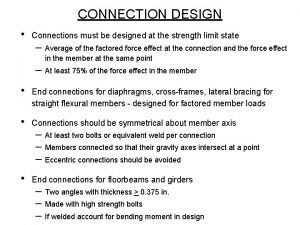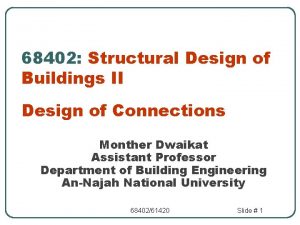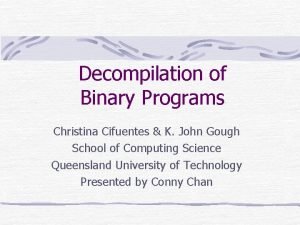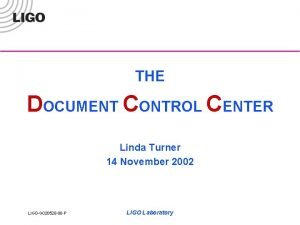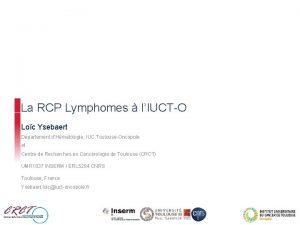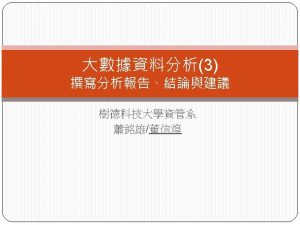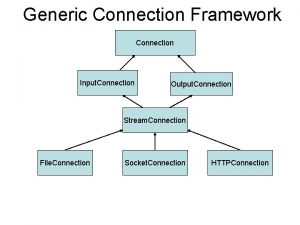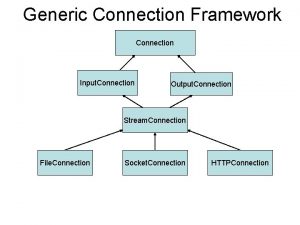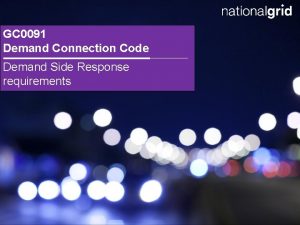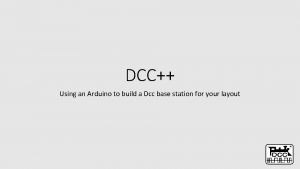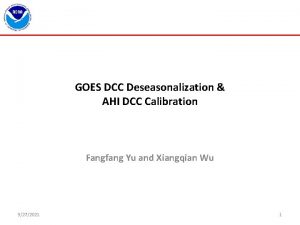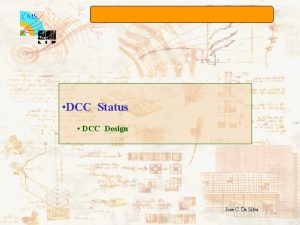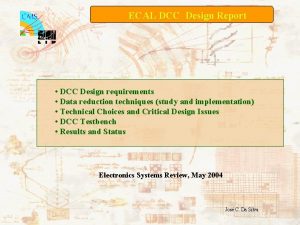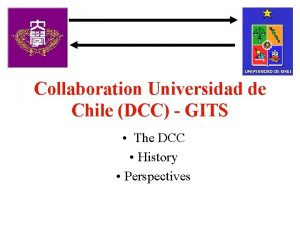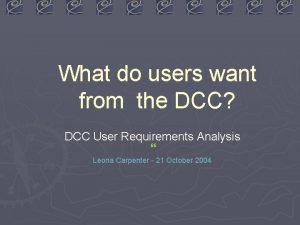GC 0104 Demand Connection Code DCC Place your


















- Slides: 18

GC 0104 – Demand Connection Code (DCC) Place your chosen image here. The four corners must just cover the arrow tips. For covers, the three pictures should be the same size and in a straight line. Antony Johnson & Rachel Woodbridge-Stocks 6 September 2017

Overview ¾ DCC Background ¾ High Level Structure of Work ¾ Scope & Proposed Solution ¾ General Requirements ¾ Short Circuit Requirements ¾ Reactive Power Requirements ¾ Disconnection and Reconnection ¾ Summary / Next Steps 2

Demand Connection Code ¾ Sets rules and requirements for different classes of new Transmission Connected Demand facilities, new Transmission Connected Distribution facilities, new distribution systems, including new closed Distribution Systems and new demand units used by a demand facility or a closed distribution system to provide demand response services to relevant System Operators and relevant TSO’s. ¾ Contributes to system security, facilitate use of renewable generation and allow more efficient use of the network and resources for the benefit of consumers ¾ Facilitates competition in the European internal electricity market. ¾ In GB it assumes that the requirements apply at the Grid Supply Point. 3

High Level Structure of Work ¾ Title I – Articles – 11 ¾ Subject Matter, Definitions, Scope, Application to existing demand facilities, Pumped Storage, Regulatory Aspects, Multiple TSO’s, Recovery of Costs, Public Consultation, Stakeholder Involvement, Confidentiality obligations ¾ Title II – Requirements for Transmission Connected Demand Facilities, Transmission Connected Distribution Facilities and Distribution Systems ¾ Chapter 1 – General Requirements (Transmission Connected Demand) ¾ Chapter 2 – Operational Notification Procedure ¾ Title III – Requirements of Demand Units / facilities to provide demand response services to the System Operator ¾ Chapter 1 – General Requirements (Demand Side Response) ¾ Chapter 2 - Operational Notification Procedure 4

High Level Structure of Work ¾ Title IV – Compliance ¾ Chapter 1 – General Provisions ¾ Chapter 2 – Compliance Testing ¾ Chapter 3 – Compliance Simulation ¾ Chapter 4 – Compliance Monitoring ¾ Title V – Applications and Derogations ¾ Chapter 1 – Cost Benefit Analysis ¾ Chapter 2 - Derogations ¾ Title VI – Non Binding Guidance and Monitoring of Implementation ¾ Title VII – Final Provisions 5

Title II – Technical Requirements Transmission Connected Distribution Facilities / Distribution System ¾ Article 12 - Frequency Range (Annex I) GC 0101 ¾ Article 13 - Voltage Ranges (Annex II) GC 0101 ¾ Article 14 - Short Circuit Requirements GC 0104 ¾ Article 15 - Reactive Power Requirements GC 0104 ¾ Article 16 - Protection Requirements GC 0102 ¾ Article 17 - Control Requirements GC 0102 ¾ Article 18 - Information Exchange GC 0102 ¾ Article 19 - Demand Disconnection and Reconnection GC 0104 ¾ Low Frequency Demand Disconnection ¾ Low Voltage Demand Disconnection ¾ Article 20 - Power Quality GC 0102 ¾ Article 21 - Simulation Models GC 0102 6

Proposed Solution ¾ Create a new section of the Grid Code “European Connection Codes” (ECC) which will duplicate the GB Connection Conditions. ¾ The ECC’s will include any additional technical requirements set out in the Demand Connection Code and if there any conflicting requirements from the CC’s, they will not be included in ECC and the requirements set out in DCC will be included instead. 7

Title II – General Requirements

Article 14 – Short Circuit Requirements ¾ Article 14 of DCC does contain some requirements which on first appearance raise a number of questions particularly in relation to general practice and health and safety ¾ During the drafting process these issues were discussed at length and it was agreed and accepted that current GB practice can continue to apply unchanged without causing a conflict with DCC. 9

Article 15(1) – Reactive Power Requirements (1) Transmission Substation Transmission Connected Demand Facility or Distribution Facility/System Maximum Power Factor Ranges 0. 9 Power Factor Lead (48% Maximum Import) 0. 9 Power Factor Lag (48% Maximum Export) Example – A Connection Point to the Transmission System has an Import (Demand) of 100 MW and an Export (Generation of 100 MW). The Maximum Reactive Power Range that the TO can specify at the Connection Point cannot exceed 0. 9 Power Factor Lead to 0. 9 Power Factor lag (or 48 MVAr import to 48 MVAr export) 10

Article 15(1) – Reactive Power Requirements (2) ¾ This requirement is new to the GB Grid Code ¾ Scope exists for optimal solutions on reactive power transfer between the TO and Demand Facility / Distribution System but the reactive range cannot be greater than 0. 9 Power Factor lead to 0. 9 Power Factor lag. ¾ The Relevant TO may use other metrics other than power factor to set the equivalent ranges (eg %, p. u, Q/Pmax, MVAr etc). ¾ The requirements apply at the Connection Point ¾ For connection points shared between Power Generating Modules and Demand Facilities any derogation sought in relation to the Connection Point shall be met at that Point and defined in the relevant agreements. 11

Article 15(2) – (4) – Reactive Power Requirements Transmission Substation Transmission Connected Distribution System The TSO may require that Transmission Connected Distribution Systems have the Capability at the connection point not to export reactive power (at reference 1 p. u) at an active power flow of less than 25% of the maximum Import capacity. Example – A Connection Point to the Transmission System has an Maximum Import Capacity (Demand) of 100 MW. If the demand at that Connection Point falls to 25 MW at a Point in time then there should be no export of Reactive Power at that Connection Point. 12

Article 15(2) - (4) – Reactive Power Requirements ¾ This requirement is new to the GB Grid Code ¾ Notwithstanding the requirements of Art 15 (1)(b) the Relevant TSO may require the Transmission connected distribution facility to actively control the exchange of reactive power at the connection point for the benefit of the entire system which shall be through joint collaboration between both parties. ¾ The Transmission Connected Distribution System Operator may require the TSO to consider its Transmission Connected Distribution System for Reactive Power Management. ¾ Query - How would Power Factor ranges be treated regarding unusual loads such as traction supplies or industrial sites such as arc furnaces etc? 13

Article 19 (1)(a)– (d) Low Frequency Demand Disconnection Comparison with GB Article 19 (1)(a)-(d) sets out the requirements related to low frequency demand disconnection functional capabilities. These requirements are already specified in GB Grid Code apart from Article 19(1)(c)(iv) – “the low frequency demand disconnection functional capabilities shall allow for operation from a nominal Alternating Current (‘AC’) input to be specified by the relevant system operator, and shall provide the direction of active power flow at the point of disconnection”. Proposal: When CC is replicated and forms ECC, add this requirement. 14

Article 19 (2)(a)– (f) Low Voltage Demand Disconnection Comparison with GB The GB Grid Code does not specify the requirement for low voltage demand disconnection nor does DCC mandate the requirement for low voltage demand disconnection. Proposal Low voltage demand disconnection requirements will not be stated in the GB Grid Code, however, should low voltage demand disconnection be required in the future it would need to be introduced via the GB Grid Code Governance process and consistent with the requirements of DCC. 15

Article 19(3)(4) Comparison with GB Code DCC Requirement GB Grid Code Article 19(3) – on load tap changer blocking As with Low Voltage Demand Disconnection, DCC does not mandate a requirement and will not be added to the Grid Code. Article 19(4)(a) – automatic reconnection following disconnection OC. 6. 7 – Emergency Manual disconnection. Article 19(4)(b) - synchronisation Synchronisation covered in Bilateral Connection Agreement and Relevant Electrical Standards (if it doesn’t cover demand it will be added). Article 19(4)(c) – remote disconnection. Not explicitly defined in the Grid Code but requirements may be covered on a site specific basis in the Bilateral Connection Agreement – Eg Auto Switching Schemes / Islanding Schemes. The general requirement will be added into ECC but the site specific requirements will be specified in agreements. 16

Questions/comments? ¾ The approach will be the same as in GC 0100, GC 0101 & GC 0102. ¾ Anything we may want to consider with regards to Articles 14, 15 or 19? 17

Summary / Next Steps ¾ Most of the Title II DCC requirements in Articles 14, 15 and 19 are either new or map to existing GB Code requirements. ¾ For the new requirements it is considered that new text consistent with DCC would be applied in the GB Code. ¾ There are no National Parameters to select in the Articles discussed. ¾ Demand Side Response Services – (Articles 27 – 30) will be discussed at the next meeting (5 th October). ¾ Title III: Chapter 1 – General Requirements will be discussed next month in GC 0104. ¾ Title III: Chapter 2 – The Operational Notification Procedure is covered in GC 0102. ¾ Only the technical requirements for new providers of DSR are covered in DCC. Information on where discussions for commercial aspects of DSR are taking place will be highlighted at the next 18 workgroup meeting.
 Pp 0104
Pp 0104 Demand connection code
Demand connection code Bolted connection
Bolted connection A490n bolts
A490n bolts Slip critical connection vs bearing connection
Slip critical connection vs bearing connection Text to world examples
Text to world examples Christina cifuentes
Christina cifuentes Amw huebsch
Amw huebsch Dcc data management plan
Dcc data management plan Dcc document control center
Dcc document control center Ysebaert loic
Ysebaert loic Dcc calibration
Dcc calibration Busceral
Busceral Chargepoint connection code
Chargepoint connection code Inventory modeling
Inventory modeling Measures to correct excess and deficient demand
Measures to correct excess and deficient demand Market demand curve
Market demand curve Dependent demand vs independent demand
Dependent demand vs independent demand Halimbawa ng demand function
Halimbawa ng demand function


